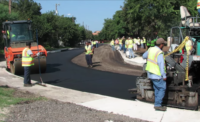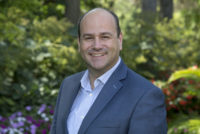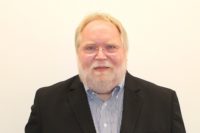Macaria Flores serves as city executive for Arcadis, with 20-plus years of strategic leadership experience in public and private sectors. She has spearheaded numerous complex projects in the Los Angeles region, including securing a 10-year financial stability plan for the Los Angeles Dept. of Public Works, developing a legislative blueprint for the City and County of Los Angeles' proposed alternative technology facilities, and securing one of the region’s largest solar developments. She began her career as an environmental scientist at California’s Regional Water Quality Control Board, and now serves on various boards, lending her expertise on environmental issues and STEM initiatives for girls.
ENR Senior Editor Aileen Cho interviewed Flores about diversity and equity in the industry. Her responses have been edited and condensed.
ENR: Tell me about your role as “city executive” for Arcadis. What does it entail?
The City Executive job at Arcadis is multidimensional. There are 16 of us throughout the globe who live, work and play and are city champions for their respective cities. I have the coolest job where I talk city trends, challenges and solutions with colleagues in New York City, Paris, London, Brisbane and Amsterdam, to name a few. We think globally but act locally.
We know how our cities work and what it takes to perform and deliver world-class work for our clients. We work across all business lines and in tandem with our pursuit, sales and operation teams. There is also a quantitative side to our role, as our growth is measured quarterly—you never want your city to be in the red! We also serve as thought leaders, representatives and account executive sponsors for key clients in our region.
ENR: Describe how you helped ensure that projects such as the LA Regional Connector and the East San Fernando Valley Rail project were approached with an equitable lens.
LA Metro and its board of directors do a pretty good job of making sure that happens. The agency already has robust small business and minority participation goals and mentor protégée programs that we take very seriously.
The fact that Metro is investing $2 billion in a light rail project in the East San Fernando Valley speaks to equity and inclusion. Historically, these areas did not receive this level of resources for infrastructure and development. One section of Van Nuys Boulevard struggles with economic investments and is located in a densely populated segment. Once built, it will bring another transit option for Angelenos who are public transit-dependent and get them to their jobs or schools faster.
Similarly, the Regional Connector is true to its name and is connecting communities that have historically been disconnected, while saving riders time with a one-seat ride.
Equity can mean different things to people. To me, equity represents connecting people to cultural attractions, sit-down restaurants, the ocean and job and educational opportunities….having options.
Through these initiatives, we have met small, minority or veteran-run businesses in our industry and many of them have strong connections and have personal investments in the communities they represent. These types of relationships are essential to a project’s success. All projects impact communities, and communities want to see project leadership reflective of their neighborhoods. On these two particular projects, I made sure our project team did that. I also ensured the individuals who would be interfacing with stakeholders had a certain level of cultural competency.
When possible, we tried to hire local firms and solicit businesses that were from the project area. These projects are in two distinct communities in Los Angeles, but they share the same ability to transform communities and become economic catalysts. Personal buy-in is important to me. When the people who are going to use that asset have the ability to be part of that transformation….we know we have success.
ENR: Did you have mentors, men or women, who really helped you in your career? Do you mentor anyone now? Do you participate in industry groups like Womens' Transportation Seminar? What are your thoughts on how to make this industry more appealing to the next generation, especially women and minorities?
I wouldn’t be the person or professional I am today if it wasn’t for the mentors I’ve had throughout my life and career. Education in my home was a must. It’s something my parents valued and expected my siblings and I to excel and master.
I was fortunate to have a high-school science teacher and mentor who filled that curiosity and pushed a small group of us “science nerds” to strive for greatness. I also watched my older sister, 10 years my senior, break glass ceilings in her male-dominated sector and excel. These two people served as my model mentors without knowing it, and were pivotal in shaping my educational and professional career.
Throughout my professional career, I have been lucky to call some amazing individuals, such as a U.S. Senator, a Congressman and heads of the state Environmental Protection Agency mentors and friends.
I am definitely a fan and strongly support groups like Women's Transportation Seminar, which are essential and serve as a beacon for many people within our industry. For me, however, it’s imperative that we cultivate that same passion in science, technology, engineering and mathematics in the next generation of leaders and professionals. When less than 15% of girls show an interest in STEM at the critical ages between 4th and 8th grade, it’s something our industry needs to address.
That’s why, for the past 5 years, I have served as a board member for DIY Girls Inc. Its mission is to expose girls to STEM experiences and careers at a young age. The girls are brilliant, strong and resilient. However, they simply lack the resources and exposure to our industry. I hope that my involvement works to minimize these barriers to achieving success. I also serve on a handful of other boards who generally have the same mission and support environmental causes.
ENR: How did you get into this business and eventually, to Arcadis?
It’s definitely been a journey. Looking back, every job I have held during my regulatory, policymaking and lobbying tenure has prepared me for the City Executive role at Arcadis. It’s incredible to think that this is a role I have had for the past 10 years…Wow!
I started off my career with the California Environmental Protection Agency at the Los Angeles Regional Water Quality Board as an environmental scientist working on many of the permits, watershed plans, stormwater regulations, etc., that you see today. I then ventured over to the City of Los Angeles, working for an elected official. I worked on some groundbreaking environmental and energy policies for his district.
My tenure with the office and the interface I experienced with various city departments cultivated priceless relationships. Not wanting to follow my elected official to Congress, I joined a prominent public affairs and lobbying firm as vice president of energy and environment. I had the pleasure of representing and obtaining results for a diverse client portfolio including Fortune 500 companies, small municipal waste haulers, new technology firms and even the County of Los Angeles.
Five years into my lobbying career, I was approached by a well-known Los Angeles stakeholder who was acting as a headhunter and tasked with identifying candidates for a new position and program Arcadis was launching in Los Angeles. I initially turned them down, but I was personally approached by the Global Cities Director during their second search and—well like they say in Hollywood—the rest is history.
ENR: Everybody talks about promoting diversity, equity and inclusion, but how are we doing as an industry? What challenges are there? Are there any lessons learned from projects like Regional Connector or East San Fernando Valley Rail?
It’s imperative that young people of color be given an opportunity to participate within not just our industry but the STEM fields as a whole. As an industry, we are doing an OK job, but we can certainly be much more inclusive with our engagement and approach.
One possible suggestion would be in creating strategic partnerships with community-based organizations and nonprofits that work in conjunction with historically Black colleges and universities or Hispanic serving Institutions. These strategic partnerships would aid in the creation of a pipeline of young minority talent within our field.
Something that I noticed during the East San Fernando Valley Rail project was the dearth and severe lack of minority project managers within a portion of the city that is heavily Latino. Even though our projects are technical in nature, they directly impact the communities we serve. That is why it’s important for us as an industry to be reflective in all aspects of our DEI engagement.






Post a comment to this article
Report Abusive Comment